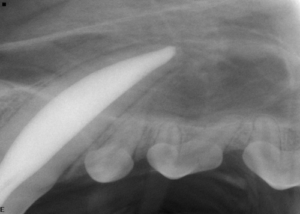Your cart is currently empty.
Broken Pet Teeth
What are they?
Broken or fractured teeth are a very common occurrence in dogs and cats. Pet teeth can break due to trauma (hit by a car, ball, or rock) or due to chewing on hard objects. Any pet tooth can break, however, some teeth are more commonly fractured than others, such as the canine (fang) teeth in the dog and the cat, and the upper fourth premolar (large tooth on the upper jaw in the back of the mouth) in dogs.

2 Types of Broken Teeth
There are two categories of broken pet teeth:
- Those that directly involve the root canal (complicated crown fractures)
- Those that do not extend deep enough to expose the root canal, but do expose dentin (uncomplicated crown fractures).
Both require therapy, but the treatment can be very different.
Important to Seek Treatment
Pet teeth with direct root canal exposure are excruciatingly painful. Unfortunately, only very rarely will animals show discomfort, as they are evolutionarily conditioned to mask pain, preferring to “suffer in silence”. This allows owners (and veterinarians) to ignore the problem, as “it doesn’t seem to bother the pet”. But we now know that these animals are suffering from consequences both in the mouth as well as throughout the body.
If a fractured tooth is not treated, bacteria from the mouth gain access to the root canal and infect the tooth. Eventually, the tooth will die and become a bacterial fortress. The bacteria then leak out through the bottom of the tooth and infect the bone, eventually causing bone destruction around the tips of the tooth root(s). Next, the blood vessels in the area pick up the bacteria and spread it to the vital organs.
Occasionally, the infection at the root tips will get so bad that an abscess will break out through the skin and appear as a wound on the face, often below the eye. Antibiotics may resolve the problem for a while, but invariably the problem will continue to reoccur if the offending tooth is not appropriately dealt with.
Thus it is no longer acceptable to ignore broken teeth in our pets/patients. We have had numerous clients who have told us that their pet is not bothered by its broken tooth when it is discovered, but later, tell us joyfully that their pet is acting “5 years younger” just two weeks after the treatment.
Treatment Options
There are only 2 options for treatment of a fractured tooth with direct pulp exposure, and ignoring it is NOT one of them.
- Solve with root canal therapy
- Remedy with extraction.
1. Root Canal Therapy Approach
The first and best option to treat a fractured tooth that is otherwise healthy is root canal therapy.
Advantages of root canal therapy over extraction of the tooth include:
- Saving the tooth
- Preserving the strength in the jaw
- Avoiding surgical pain
- Especially for large teeth
- Decreases risk of surgical complications
- Learn more about root canal therapy.
Following root canal therapy, a full coverage cast metal crown is recommended to strengthen the tooth.

2. Extraction Approach
The other option is the extraction of the offending tooth.
Choosing this treatment option may depend on the tooth involved, degree of fracture, and any other disease issues.

Extraction is the least ideal option for the most “strategic” (i.e. useful) teeth which include the canine (fang) tooth, as well as the upper fourth premolar and lower first molar teeth in dogs this is the last option.
 There are several reasons we prefer not to extract these teeth if possible.
There are several reasons we prefer not to extract these teeth if possible.
- These are very large teeth with very large roots in animal patients. The root of the canine tooth is twice as long and wider than the crown (the part you can see). Extraction of these teeth requires more invasive oral surgery.
- The patient loses the function of the tooth, which can be very important for chewing in some cases.
- Orthodontic problems can occur as a result of the loss of the tooth. See more about lip-catching.
We try to avoid extraction in cases of otherwise healthy teeth.
Crown Fractures
Crown Fractures
Uncomplicated crown fractures are approached with different treatment options. These are also a very common finding on the oral exam, particularly in large breed dogs. The most common teeth involved are the carnassials (maxillary fourth premolar and mandibular first molar), as they are the primary chewing teeth. However, any tooth can be fractured.
These fractures almost always result in the exposure of the underlying tooth structure called dentin, creating significant pain for the patient. This is like us humans having a sensitive tooth from a deep cavity.
Some of these teeth will die and become infected. As a matter of fact, a recent study by Dr. Niemiec (linked below in further research) showed that almost ¼ of these teeth are infected. Thus, it is recommended that these teeth be radiographed to ensure vitality. If the teeth are dead (evidenced by the bone loss at the tips of the teeth), the teeth need to be root canalled or extracted. If the teeth appear to still be alive, the application of a bonded sealant is recommended to decrease sensitivity, block off the pathway for infection, and smooth the tooth to decrease periodontal disease. This has been shown to be a highly effective means of therapy.

